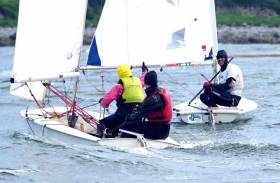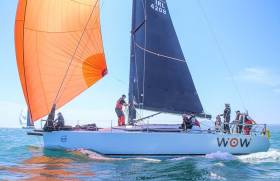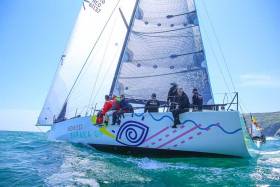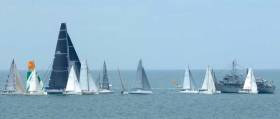Displaying items by tag: Round Ireland
The Smallest Boats To Sail Round Ireland – A Story of Courage & Character
The contrast could not have been greater writes W M Nixon. On Friday, September 14th on Ireland’s relatively sheltered East Coast, 302 Laser dinghies came in from Dublin Bay to Dun Laoghaire’s elegant and busy harbour to conclude the penultimate day’s racing in the Laser World Masters 2018.
And away to the west at the head of Galway Bay, a lone Laser came into Rinville to receive the enthusiastic greetings of a welcoming flotilla, and the homely embrace of Galway Bay Sailing Club.
Richard Hayes had completed his solo epic, a round Ireland voyage which had seen him log a total of 1,324 sea miles (2,452 kilometres) in 54 sailing days.
But they were by no means 54 consecutive sailing days. For he had happened to hit on just about the most awkward summer for sailing a Laser round Ireland that we’ve had for a decade, with many days unsuitable for sailing for various reasons, ranging from prolonged flat calm to two named storms – Hector and Ernesto – and going on to include seven days of impenetrable fog and three capsizes.
 The Ireland challenge. While a Laser can slip through inside Achill Island with no bother, and Richard Hayes was even able to avail of the old canal inside the Mullet Peninsula at Belmullet in northwest Mayo, there are long stretches of inhospitable coast where you just have to keep on sailing.
The Ireland challenge. While a Laser can slip through inside Achill Island with no bother, and Richard Hayes was even able to avail of the old canal inside the Mullet Peninsula at Belmullet in northwest Mayo, there are long stretches of inhospitable coast where you just have to keep on sailing.
He took his departure from GBSC at their Open Day on Sunday, May 27th, and sailed into an exceptionally lengthy period of windless high pressure. So totally calm was it that, with the need to find somewhere to stop each night, it took him ten days to get clear beyond Slyne Head from Galway Bay itself in order to start the first northward major stage of his clockwise circuit.
Already, it seemed likely that the circuit was going to take much longer than the eight-nine weeks he’d originally envisaged. That in itself would have deterred many, who would at the very least have postponed until a more favourable weather pattern began to develop. But this was no light-hearted venture undertaken on a whim – he was determined to simply keep going on until he got there.
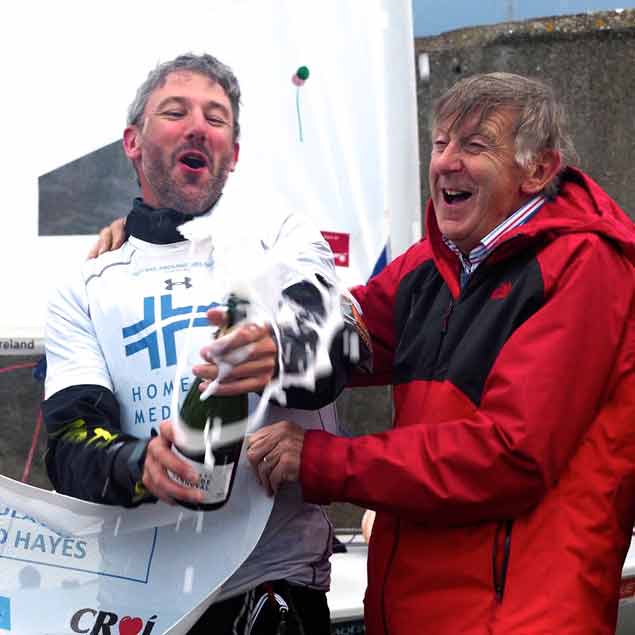 Richard and his father Michael celebrating the safe completion of the voyage at Galway Bay SC. While Michael drove 4,000 miles in all with the little Campervan in the hope of being able to provide shore support everywhere possible, there were inevitably stages where Richard was very much on his own. Photo GBSC
Richard and his father Michael celebrating the safe completion of the voyage at Galway Bay SC. While Michael drove 4,000 miles in all with the little Campervan in the hope of being able to provide shore support everywhere possible, there were inevitably stages where Richard was very much on his own. Photo GBSC
Richard Hayes – as the photos show – seems a perfectly normal 40-something, as ready for a laugh and good company as the next man. Yet there’s a serious and thoughtful side to him, and two or three years ago, thanks in part to his work in Galway as a Chartered Physiotherapist, he became even more aware of the woeful lack of provision for cardio-vascular problems, and particularly the shortage of defibrillators and trained users at key locations. So the idea developed of a very special fund-raiser in support of the Galway-based CROI Heart & Stroke Charity, and it increasingly became something which had to be done before he could get on with the rest of his life.
Doing it through a very special sailing achievement seemed the most natural way. From Tipperary originally, he was introduced to sailing at the age of eight by his late mother on Lough Derg, and was soon in the thick of it, active on the junior racing front at events all over Ireland.
He showed a talent for teaching sailing, and in 1993 was signed on for a summer as Junior Instructor at Galway Bay Sailing Club. The West Coast soon had him in thrall, though his sailing experience was widening to include cruiser-racing in Galway, Cork and Dublin, while a spell in America saw him actively crewing several boats, the largest a fifty footer.
 Galway Bay SC, Richard Hayes’ “Home-from-Home” club. Photo: GBSC
Galway Bay SC, Richard Hayes’ “Home-from-Home” club. Photo: GBSC
But Galway was always where it was going to be despite his ties to his boyhood home, such that even after 15 years of living and working in the western city, he still refers to Lough Derg YC as his “home club” and Galway Bay SC as his “home-from-home” club. He was drawn to the health field and particularly physiotherapy, an interest to which the fairly athletic Laser sailing gave an added edge. And the Laser in turn provided the vehicle to make his fund-raiser a manageable proposition. As the various sections of the project were worked into place, he received direct sponsorship support for the voyage itself from Homecare Medical, Galway Crystal, Optique and the renowned Mary’s Fish Shop in the city, while the national names which chipped in included CH Marine, Dubarry and Marine Parts Direct.
As we shall see, solo-sailed Lasers have been taken round Ireland before. Indeed, there’s even a boat a tiny bit shorter in overall length which had done the circuit, albeit with two on board for most of the venture, and a shorter circumnavigating sailboard too. But there’s something about the perfection of the 4.2 m (13ft 9in) Laser which chimes so well with the unique demands of a round Ireland voyage that when it is done with a Laser, it is always as though it is being done for the first time.
You’re so closely in touch with nature, and yet still seeing it from the slightly separated world of a boat, that sailing a Laser round Ireland is to a significant extent a spiritual thing. It’s probably as near as a modern boat can come to providing a meaningful link to the voyaging monks of our ancient history, and their astonishing achievements along and away from the Irish coast in frail currachs.
It’s something which seems in no way diminished by the availability of modern communications, because for very long periods, no matter how much shore support you’re receiving, you’re inevitably very much on your own. This was emphasised in Richard Hayes’ case, for although his father Michael gave over his summer to driving a well-used campervan along the coast to be there when his son came into port, the roads by no means closely follow the shore, and some of the tiny gaps in the cliffs the Laser had to seek shelter in were unreachable by road.
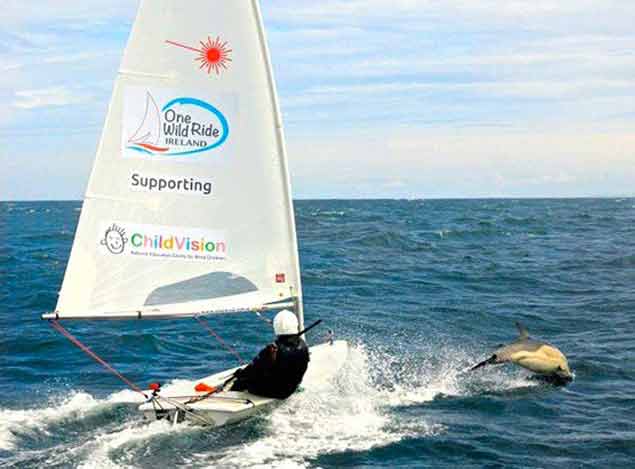 Gary ‘Ted’ Sargent – complete with safety helmet – on his way solo round Ireland in 2016. In addition to the company of dolphins, he had a support boat. Photo courtesy Gary Sargent
Gary ‘Ted’ Sargent – complete with safety helmet – on his way solo round Ireland in 2016. In addition to the company of dolphins, he had a support boat. Photo courtesy Gary Sargent
Unlike his friend Gary ‘Ted’ Sargent of Howth, who did the Laser Ireland circuit from Schull to Schull in 2016 as a fund-raiser for the charity ChildVision with an on-water support team somewhere nearby with a RIB, Richard Hayes’ voyage for CROI was done without any support team afloat, though from time to time along the coast, he would get friendly supportive company from other boats.
Basically, he’d decided it would be more manageable on his own at sea, with his father Michael as near as possible (and sometimes it’s not really near at all) with the Campervan. Thus the planning beforehand included the detailed study of aerial photos of the coast, particularly the many sections dominated by cliffs, where prior knowledge of even the tiniest possible landing place hidden in the coastal wall could be a life-saver in the event of a sudden deterioration in the weather.
Although he was on his own at sea, it was very much a family effort, with his sister Libhin continually monitoring him remotely on a choice of two tracking devices, while his other sister Michelle was on admin and is continuing with the fund-raising, which is ongoing and eventually hopes to raise €15,000 for CROI – you can contribute to it here
Along the coast, his father Michael’s patience and supportive enthusiasm was a great strength, for the voyage gathered its own momentum, and Richard found himself being conveyed to interviews with local radio stations and other centres of communication, such that he has arrived back with an even stronger belief in the good heart of Ireland’s smaller communities, and the complete, generous and unquestioning kindness of strangers who took him into their homes and provided for his every need, reinforced by the way in which they readily accepted that he and his family should be doing a thing like this.
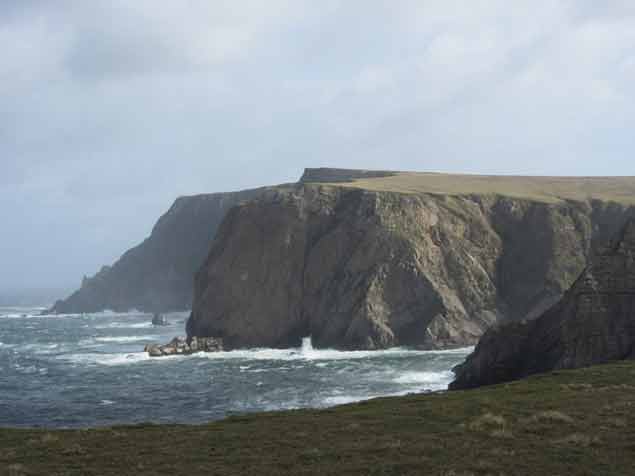 The unforgivingly grim cliffs of North Mayo. Richard reckons that when you’re spending a lot of time sharing space with a coastline like this, sometimes it’s better to concentrate entirely on your own little world in sailing the boat
The unforgivingly grim cliffs of North Mayo. Richard reckons that when you’re spending a lot of time sharing space with a coastline like this, sometimes it’s better to concentrate entirely on your own little world in sailing the boat
Speaking to him through this past week has possibly been too soon after the experience to expect his thoughts and recollections to be fully processed. Perhaps they never will be fully processed – maybe he’ll always find that there’s some new angle on a thought or experience which will develop beneficially. But certainly in speaking with him it seemed that here indeed was someone whose body had moved through so much experience that it was still waiting for his soul to catch up……
That catching-up of the soul will be an enriching experience. But as it is, his memories – a colourful bundle of contrasts – tumble out. Although he started in what became an all-pervading calm over most of Ireland, up in northwest Mayo and Donegal he found – as many have before – that they have their own weather systems entirely. But one of the joys of sailing a Laser on a project like this is that you can simply go inside islands inshore and offshore which have to be taken on the outside by deep-draughted high-masted boats, and thus he blithely went through Achill Sound without needing to wait for a bridge-opening, and equally he was able to avail of the almost-forgotten fact that there’s a canal at Belmullet inside the Mullet peninsula, closed off to most boats by a road bridge, but no problem for a Laser.
However, north of Belmullet the heavily-cliffed Mayo coast is daunting in the exteme, and it looked so grim with visibility closed in that Richard said the best thing was to put looming cliffs out of his mind for a whole, concentrate on the sailing and find a safe haven in Portacloy, which he duly did. If you’ve ever been to the remote cliff haven of Portacloy, you’ll know it’s not the sort of place you’d associate with the fun sailing of a little Laser.
 A major turning point is finally reached – approaching Fair Head, Ireland’s most northeasterly point. Photo: Richard Hayes
A major turning point is finally reached – approaching Fair Head, Ireland’s most northeasterly point. Photo: Richard Hayes
But as he gradually made his way along the much indented coast of Donegal, monumental coastlines became part of the daily visual diet – it’s big country. And it by no means fades to domestic scale as you get on to the north coast – everything is rugged until you get right round to Belfast Lough, when the prosperously green County Down coast is such that sometimes the Mountains of Mourne seem more like garden ornaments than the real thing.
There was much windward work, and with his professional training, he was well aware that maintaining a virtually fixed position for hours and end in order to keep the Laser at optimum speed was physiotherapy hooliganism, so there were times, such as on a long leg on the wind laying along a coast, that he simply had to tack for a while for all that it wasn’t making ground, simply to let his muscles and bones stretch in a different direction. Then at other times with wind strengths fluctuating wildly, he’d have to be prepared to put into any nearby beach to change down the rig size.
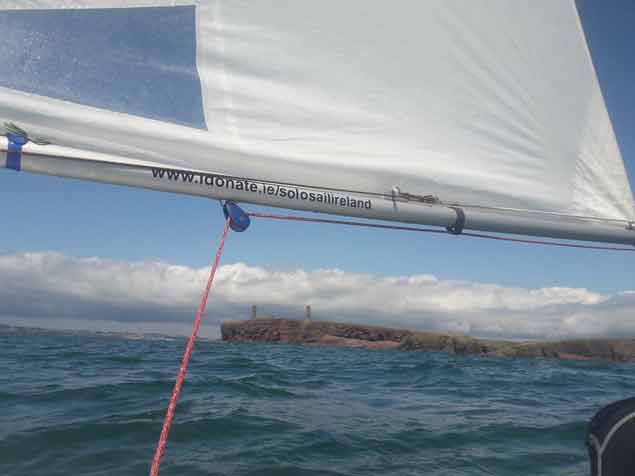 Onto the south coast at last, and approaching the headland at Tramore Bay with its three towers, one of which is topped by the famous Metal Man. This was a good passage-making day that began at Slade to the eastward of Hook Head in Wexford, and finished at Bunmahon along Waterford’s Copper Coast. Photo: Richard Hayes
Onto the south coast at last, and approaching the headland at Tramore Bay with its three towers, one of which is topped by the famous Metal Man. This was a good passage-making day that began at Slade to the eastward of Hook Head in Wexford, and finished at Bunmahon along Waterford’s Copper Coast. Photo: Richard Hayes
But then at the end of a day’s sail along less challenging coasts, he would shape his course for a useful little bay with a beach, and having passed the entrance to Cork Harbour he “made port” at Fountainstown, linked up with his father, and found ready new friendships ashore among those who live by the beach, including Sue McWilliam, wife of the recently-retired Des of the sail-making clan.
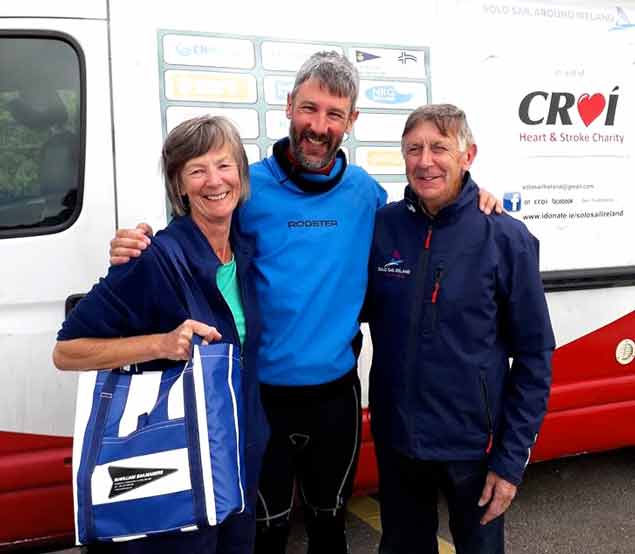 Friends met and made along the way….Sue McWilliam with Richard and Michael at Fountainstown Beach outside the entrance to Cork Harbour. Photo courtesy Richard Hayes
Friends met and made along the way….Sue McWilliam with Richard and Michael at Fountainstown Beach outside the entrance to Cork Harbour. Photo courtesy Richard Hayes
Such moments of friendly contact ultimately emphasised how necessary it was to press on if conditions suited next day, but in time he got round the Old Head of Kinsale and down to West Cork, stopping among other places at Tragumna and then next day on west through Gascanane Sound and into Crookhaven, where everything came to a stop for days with dense fog and weather warnings.
The season was getting late by this stage, and the window was becoming very narrow by the time he got past the Mizen and on -with various stops - for the most westerly point at Blasket Sound, by which time Richard and his team might reasonably have hoped they were approaching the home stage. But County Clare was determined to severely test this Tipperary man with his Galway notions, and along the cliffs between Loop Head and Kilkee – an unbroken wall of rock you might well think – he was grateful to have the knowledge of a tiny cove from his prior research, for he came out of a capsize badly in need of somewhere to recover, and this secret ‘Hayes Haven’ was nearby and just the job for those in peril on the sea.
Eventually he got to Liscannor in North Clare with September well upon him, and no progress with Small Craft Warnings in abundance. But there was only a passage of just under fifty miles left. Admittedy it was along the Cliffe of Moher and past Doolin and along the Burren round Black Head and into Galway Bay past Ballyvaughan. Spectacular stuff. But he felt that with just one clear day he could knock it off.
 It doesn’t need an exceptionally large running sea for a Laser hull to become invisible when sailing the Atlantic. Photo courtesy Richard Hayes
It doesn’t need an exceptionally large running sea for a Laser hull to become invisible when sailing the Atlantic. Photo courtesy Richard Hayes
On Wednesday, September 12th, that day came, a brief day of sailing perfection - fair winds and many accompanying dolphins friendlier than he’d seen at any time during the voyage, and the 48 fantastically varied and dramatic sea miles to Galway city knocked off in less than eight hours, the passage of a lifetime.
There was a day to gather himself, and then the welcome home on Friday evening to Galway Bay Sailing Club. Richard Hayes had done his bit and then some, but the fund-raising continues.
That’s the way it is with sailing epics in the 21st Century. Charitable fund-raising is a given. It was the same with Gary Sargent’s circuit for ChildVision in 2016. And in both cases, it was also the Laser which was the gift itself which just kept on giving. For in 2016, the Laser also gave us Annalise Murphy’s Silver Medal at the Rio Olympics. And in 2018, in addition to Richard Hayes’ great voyage, the little boat gave us the Laser Masters Worlds, an event in the utmost spirit of generosity.
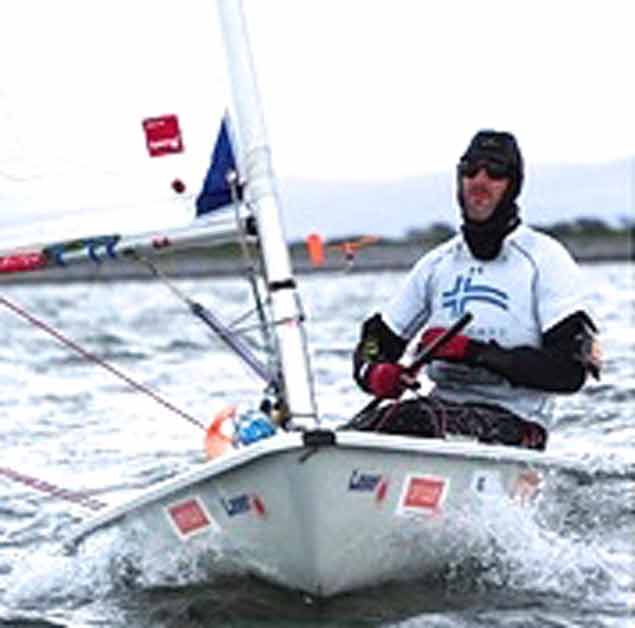 Into the final mile to the finish at GBSC
Into the final mile to the finish at GBSC
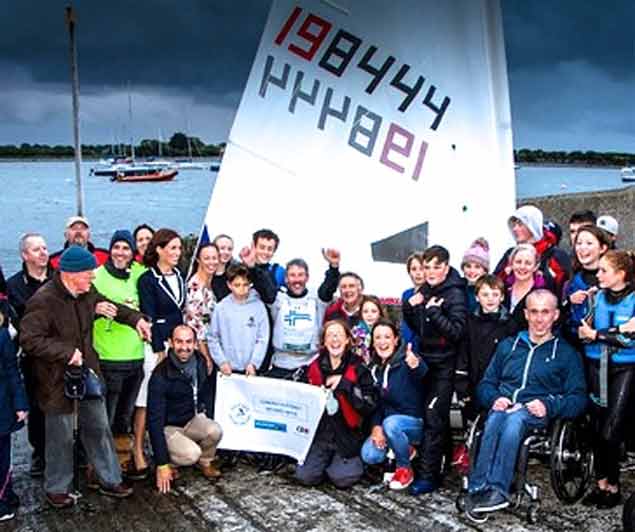 Welcome home and well done – the reception at GBSC
Welcome home and well done – the reception at GBSC
It all makes life in the 20th Century and way back in the previous Millennium seem almost buccaneering, for want of a better word. Back in the 1900s, if some somebody wanted to sail a small boat round Ireland, they just went off and did it, telling as few people – if any – as possible. Partly this was because the admittedly much more sparse officialdom of those days might have tried to prevent it, but it was also to save one’s parents from worry, because the west coast of Ireland in particular had a scary reputation.
Thus among young sailors it was thought quite something in 1961 when Kevin and Colm MacLaverty and Mick Clarke went round Ireland in three-and-a-half weeks in the 18ft Belfast Lough Waverley Durward. A Waverley is a bit like a carvel-built Mermaid made just one foot longer, and with a keel, which made Durward the smallest keelboat ever to go round Ireland.
 Back in the mists of time……..the 18ft Durward well into the latter half of her pioneering clockwise round Ireland circumnavigation in 1961, seen here in Sheephaven in Donegal with Colm MacLaverty and Mick Clarke on board. Photo: Kevin MacLaverty
Back in the mists of time……..the 18ft Durward well into the latter half of her pioneering clockwise round Ireland circumnavigation in 1961, seen here in Sheephaven in Donegal with Colm MacLaverty and Mick Clarke on board. Photo: Kevin MacLaverty
Yet a significantly smaller boat was to make the circuit unaccompanied in 1976. Thus was the unstoppable, inimitable James Cahill of Clew Bay, who took an open 13ft 6ins clinker sailing dinghy - which he’d built himself - right round Ireland, usually with one crew, but at some stages he was on his own. He not only survived, he subsequently thrived and made an Atlantic circuit cruise with a 42ft steel cutter Ricjak which he’d also built himself, and these days he cruises in a Maramu 54 ketch and is renowned for his extensive collection of Irish currachs, representing every known type.
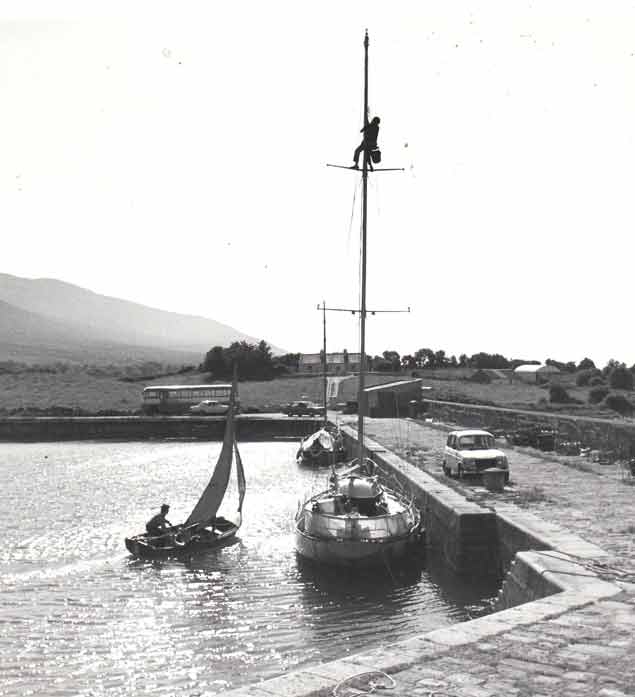 James Cahill bringing his 13ft 6ins sailing dinghy alongside Tad Minish’s yawl Kiff at Murrisk on Clew Bay in 1978, two years after he’d sailed the little boat round Ireland. Photo: W M Nixon
James Cahill bringing his 13ft 6ins sailing dinghy alongside Tad Minish’s yawl Kiff at Murrisk on Clew Bay in 1978, two years after he’d sailed the little boat round Ireland. Photo: W M Nixon
But then in 1981, Belfast Lough came centre stage again with Rob Henshall of Cultra, who went round Ireland alone in a canoe. There are other canoeists who have circled Ireland, but doing it solo is still in a class of its own. However, Rob Henshall was only getting started, for nine years later in 1990 he went round solo on a Laser. Not only was he unaccompanied by a support boat, but he had no means of non-visual contact with the shore, and no shore team either.
 Rob Hensall with the Laser he sailed round Ireland in 1990
Rob Hensall with the Laser he sailed round Ireland in 1990
He set himself very high if slightly crazy standards, for after the Laser episode he got to thinking of doing it on a sailboard. By this time he was a water-specialist instructor at the Gortatole Outdoor Education Centre in Fermanagh, but heaven alone knows what the powers-that-be might have made of his plan. For the core of it when he did it in 1992 was total self-reliance both afloat and ashore if need be, though when he reached shore he often found that kindness of strangers which is very much part of the Irish coastal experience.
He took a 3.7 m Bic sailboard which at 12ft 1in is the shortest vessel to have made the circuit, and despite loading himself with a backpack and the board with minimal but essential gear in a mainpack on the “foredeck”, he got round in 45 self-reliant days, losing two stone in weight in the process although he was definitely carrying no spare flab before he went.
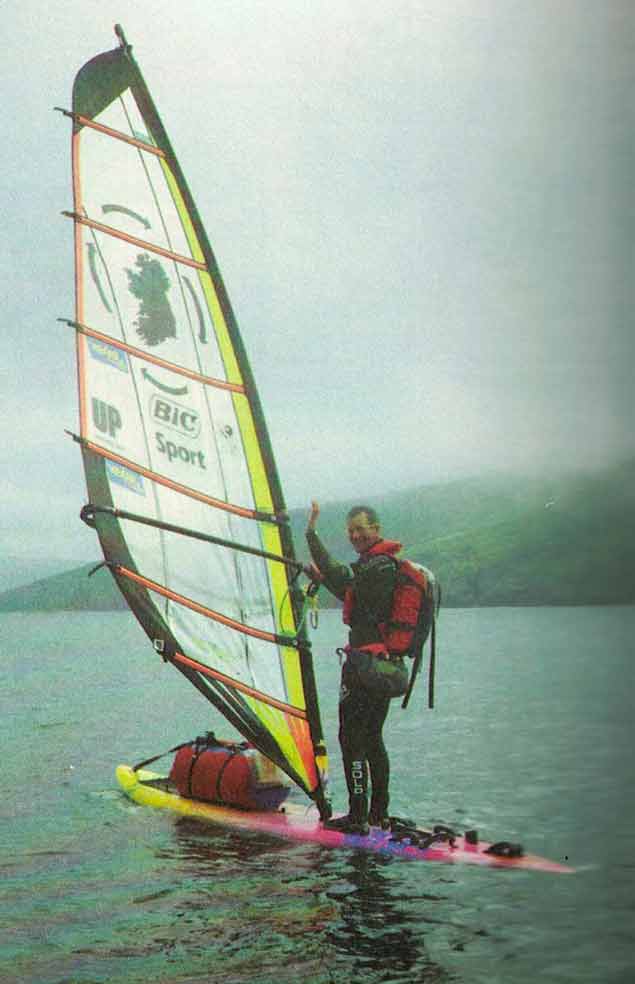 Will he ever get it to move at all? Rob Henshall departs on his heavily-laden Bic sailboard in 1992. Photo courtesy Rob Henshall
Will he ever get it to move at all? Rob Henshall departs on his heavily-laden Bic sailboard in 1992. Photo courtesy Rob Henshall
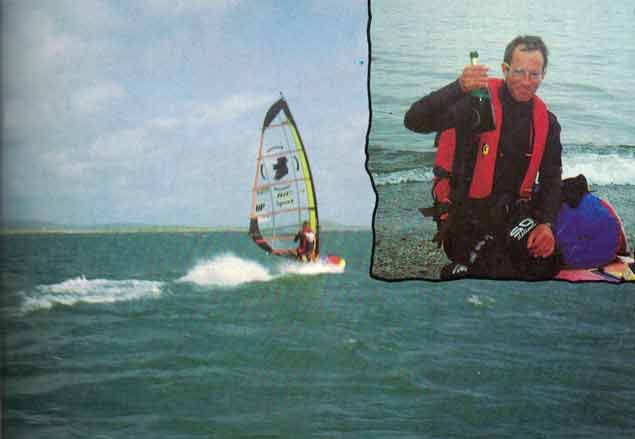 Yes he did get it to move……the laden Henshall sailboard making knots, with (inset) Rob relaxing when he completed another passage. Photos courtesy Rob Henshall
Yes he did get it to move……the laden Henshall sailboard making knots, with (inset) Rob relaxing when he completed another passage. Photos courtesy Rob Henshall
Since then, he too has settled down, but there was a flash of the old Rob Henshall a few years ago when the dollar was in freefall and the internet made the availability of bargain boats in America very accessible. So he nipped over in the Autumn and bought a 40ft ketch and simply sailed her straight across the ocean to his new sailing home in Lough Swilly. A Transatlantic passage in a medium-sized sailing boat when October is veering towards November does not accord with received opinion, but then very little of Rob Henshall’s seaborn activities ever did.
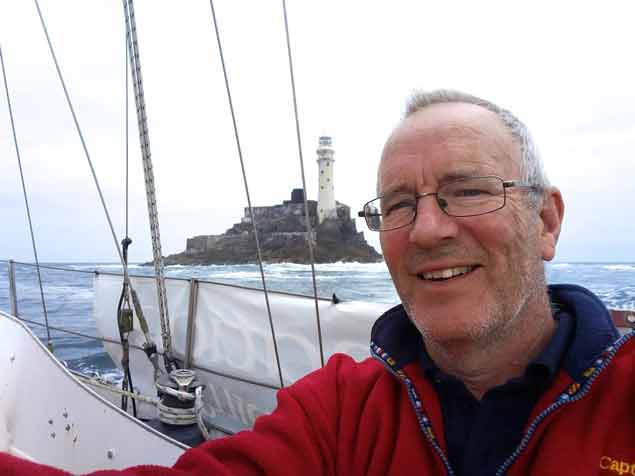 Rob Henshall as he is now, during a sail past the Fastnet Rock with his ketch Inspiration of Swilly. Photo courtesy Rob Henshall
Rob Henshall as he is now, during a sail past the Fastnet Rock with his ketch Inspiration of Swilly. Photo courtesy Rob Henshall
The fact that we are considering them again is thanks entirely to Richard Hayes’ great achievement. Think what you like about his voyage being made unaccompanied by a support boat, but it achieved its purpose in style. It showed courage and determination of a high order, it gave us a privileged glimpse into the life and dynamics of a very special family, and it was for a very worthy cause – that donation link again is www.idonate.ie/solosailireland
We can be quite sure that he and the others who made these special voyages endured considerable hardship and struggle at times. But now and again the conditions smiled on them, and we end on a high note with the vid from Richard’s final 50 mile passage from Liscannor round into Galway Bay. Shortly after he got to Galway Bay SC itself, the weather shut down completely, and has been going totally haywire ever since, so this glimpse of that vital final weather window is doubly precious here
As to the future, there’s a whisper that the three Laser solo circumnavigators may be having a get-together before Christmas. You’d guess that Comfort Zone Sailors need not apply…..
 Laser solo circumnavigator Gary ‘Ted’ Sargent celebrating at Schull on completion of his voyage in 2016. Photo: Tom MacSweeney
Laser solo circumnavigator Gary ‘Ted’ Sargent celebrating at Schull on completion of his voyage in 2016. Photo: Tom MacSweeney
British Duo Set New Round Ireland RIB Speed Record
#Record - Marc Lyne and Dean Watson have smashed the longstanding under-30ft Round Ireland powerboat record by almost half an hour, pending UIM ratification.
On Friday 13 July last the duo set a provisional time of 18 hours and 12 minutes — some 25 minutes faster than Philip Fitzgibbon and Mike Shanahan’s RIB record of 18:38:50 set in 2009.
And Lyne claims the time could have been more than two hours’ better “if we had not been beaten up for the last 40 miles from Cork to Crookhaven”.
While Team Hibernia set a sub-13-hour time with their wave-piercing powerboat in 2016, the record for under-30ft boats was still standing. And that’s the time on which Lyne and Watson put their sights after breaking the Round Anglesey time, in Watson’s home waters, back in 2015.
Over the next three years, the pair set about preparing their boat, a Scorpion 8.5m RIB dubbed Ocean Devil, to make the most of its Yanmar 315HP inboard engine.
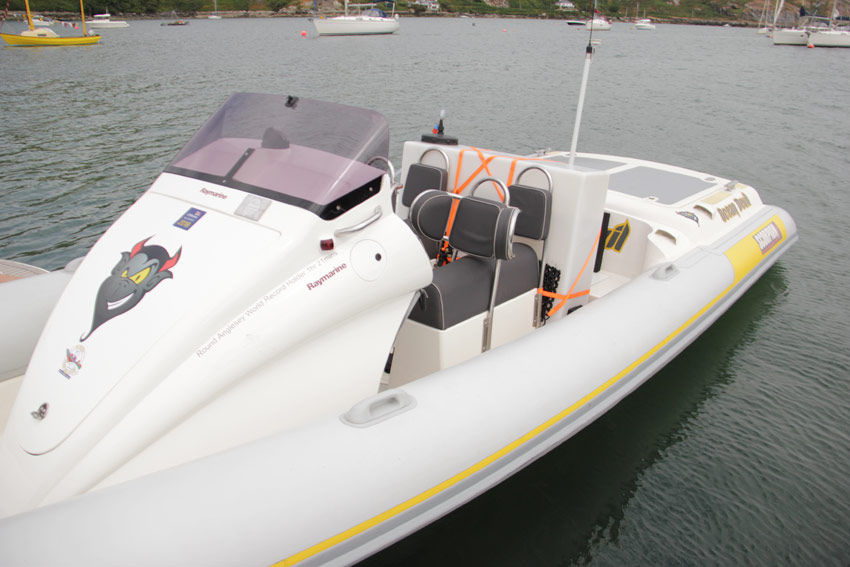 The Scorpion 8.5m RIB Ocean Devil prepped and ready to go
The Scorpion 8.5m RIB Ocean Devil prepped and ready to go
That involved a series of main prop modifications, as well as the installation of new fuel tanks with 400 litres’ capacity in addition to the 363l main tank, all while still getting as close as possible to the RIB’s top speed of 51 knots without revving over 3,750 rpm.
A key element of their set-up was using gravity to tap into the main tank through the service hatch by the helm, to avoid the use of battery-sapping pumps adding unnecessary weight.
With 45 knots achievable when fully loaded, and the engine mount put through rigorous sea and wake trials in the Solent, the next step was to reduce the overall weight. That meant new batteries, courtesy of DMS Technologies, and replacing the heavy A-frame with a removable radar post and a carbon post for the VHF antenna.
Safety remained paramount in their modifications, with all navigation lights replaced by LEDs, a new radio with built-in AIS from Raymarine, and a full set of offshore flares.
With the new and improved Ocean Devil ready for action, what Lyne and Watson needed next was a winning strategy. Cue a consolation with Mike Deacon, a RIB speed record breaker in his own right, who offered a list of suggestions — the most important of which was to wait till the weather was just so.
“The reason he and David his son had never attempted the Ireland world record was that you had to get the weather exactly right, and that would mean having the boat in Ireland and ready to go at 24 hours’ notice,” Lyne says. “So really, the people best placed to attempt the record were already in Ireland.”
Fast forward to summer 2018 — the best experienced in Ireland for years — and all the pieces were in place for a record run.
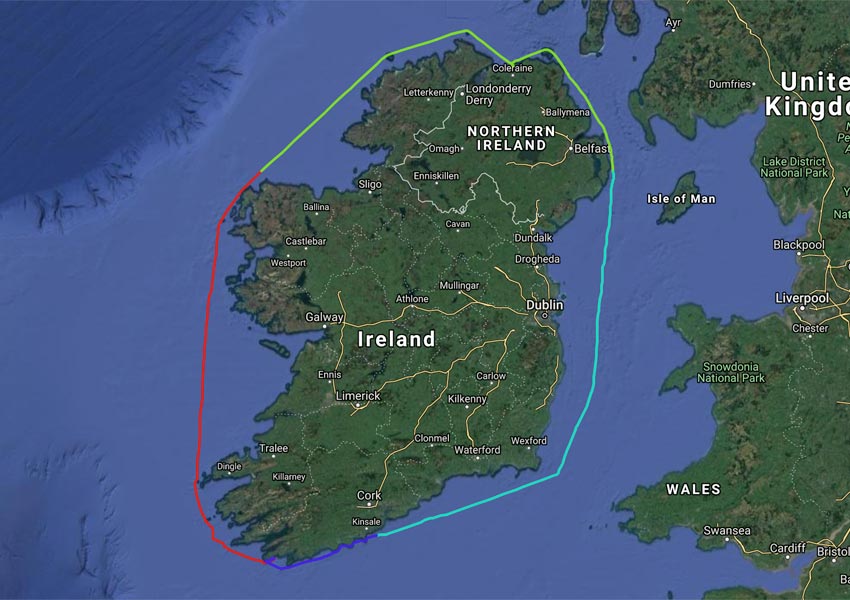 Course plotted: Lyne and Watson’s planned stages around the Irish coast
Course plotted: Lyne and Watson’s planned stages around the Irish coast
With the support of Denis Dillon at Irish Sailing, and Stena Line’s Fishguard-Rosslare ferry route, Lyne and Watson were soon in Skibbereen fuelling up ahead of their planned start in Crookhaven.
Dillon put the duo in touch with Justin McInerney, a previous Round Ireland record holder with Team Pulsar Racing, who would be their official timer on the day. His advice on the best stops to avoid busy slipways would prove crucial to their success.
With their boat and safety equipment checked over, and the passage plan forward to Ireland’s four main coastguard stations, Lyne and Watson made an early start at 4am on Friday 13 July.
That date would be true to its reputation as the duo rounded their first headland and ploughed headlong into a confused three-metre sea, halving their speed to 25 knots.
Thankfully that struggle was only for the first hour, and the rest of the day would prove to be an exceedingly lucky one, with flat seas and quick refuelling stops most of the way from Kerry to Portrush to Rosslare.
Spirits were high as the duo neared Cork late on Friday afternoon to complete their loop, only to run into that confused sea state once more — and a mishap on leaking hydraulic fluid that saw Watson bash his knee on top of a strained hip.
Lyne recalls of those dreaded final hours: “We can’t get any speed without getting hit hard occasionally which is taking its toll on both of us as we have been going for 16 hours. We duck behind the headlands, get some speed, then get beaten up as soon as we have to round the next headland.
“We remember to cut outside of all charted land as there are a few very small islands marked in some of the bays. We are losing a lot of time; rough calculations show us matching the current record – no!”
A little further on, and their situation improves: “I have the heading line on the plotter set to 12 miles, and can see the length of the line versus Fastnet Rock, which we are to round and then head towards Mizen Head,” Lyne remembers. “It’s three line lengths and we are down to 25 knots … that’s an hour and a half, that means we will equal the record.
“Dean moves to sit behind me so he can use his legs efficiently to cushion any impact without slipping.
“All good, we are on top of it now, back up to 35kt, then 40kt. The waves are getting smaller and more regular as we get to Fastnet Rock, round Fastnet, to finish at Mizen Head, torch in hand.
“Justin is on the radio: ‘Congratulations lads, you have done it.’”
Attempting and breaking this record “has taught me a few other things about life, boating and Ireland,” Lyne says, singling out Justin McInerney and “superstar” Denis Dillon for their assistance.
“I started a conversation with Denis over a year ago, and once he knew we were serious for July 13th, he did everything in his power to make it happen.”
McInerney, meanwhile, put in a call to Philip Fitzgibbon, one of the record holders Lyne and Watson have tentatively dethroned, to tempt a comeback challenge somewhere along the line.
As for Lyne and Watson’s trusty Ocean Devil, and how it fared from those 18 hours at sea? Nothing broken, though a handful seals need replacing — surprising little needed after so long flat out around the island of Ireland.
Besides Denis Dillon at Irish Sailing, and Justin and Antoinette McInerney, Lyne and Watson also expressed their tanks to Raymarine, DMS Technologies, Stena Line, BIBOA (Mike Deacon, Chris Strickland, Neil McGrigor), Claire at Marconi House in Crookhaven, and Mark at the Barleycove Beach Hotel near Mizen Head.
Steering Problems Force WOW Out of Round Ireland Race
The Royal Irish Yacht Club's Farr 42 WOW has retired from the Volvo Round Ireland Race due to steering problems.
It is understood the starboard-hand wheel collapsed when the former Irish yacht of the year was leading in IRC One. On safety grounds, the decision was taken to retire.
According to the race tracker, the George Sisk owned boat is now in Galway. All crew and boat are safe.
 Farr 42 WOW – starboard wheel collapsed Photo: Afloat.ie
Farr 42 WOW – starboard wheel collapsed Photo: Afloat.ie
Seven boats from a starting fleet of 56 have now been forced out of the Race, mostly due to gear failure in the testing conditions experienced on the West Coast.
One boat retired for a precautionary medical check for a crew-member who received a minor shoulder injury after a fall on board.
As Afloat.ie previously reported the sole trimaran in the race, Hugo Karlsson Smyth was an early loss on the south-west coast.
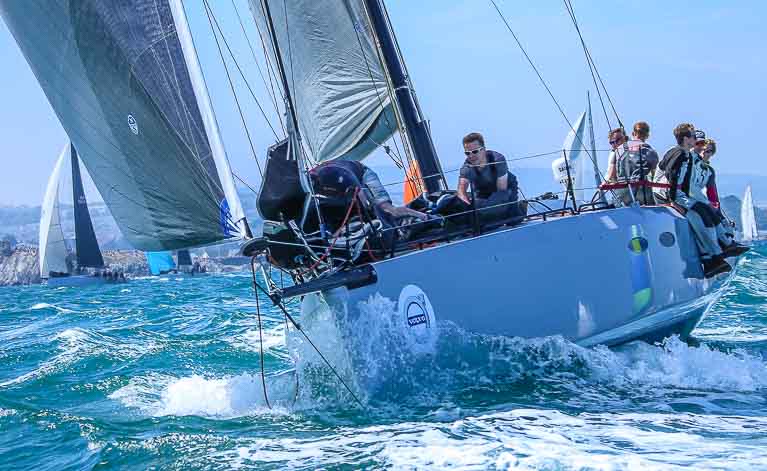 Mark Emerson's Phosphorous II retired due to gear failure Photo: Afloat.ie
Mark Emerson's Phosphorous II retired due to gear failure Photo: Afloat.ie
Also out are Mark Emerson's A13 Phosphorus II, Brian McMaster's Cookson 50 Riff Raff, Paul Jackson's Sun Odyssey 40 Wild Spirit, Johnny and Jamie Ritchie's Dufour 41 Classic Mingulay, and Glyn Sheffield's Farr 40 Espresso Martini Too.
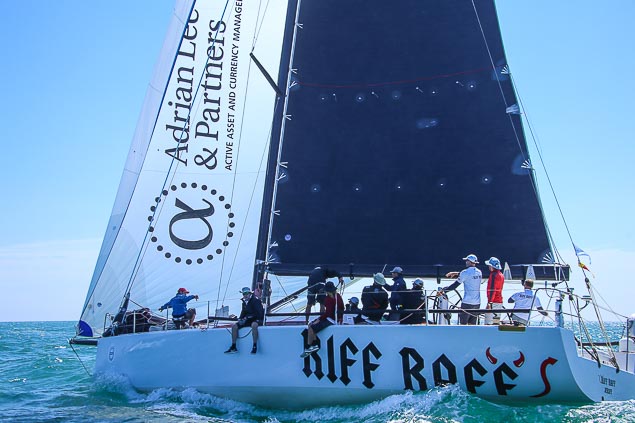 Brian McMaster's Cookson 50 Riff Raff retired and headed for Crosshaven Photo: Afloat.ie
Brian McMaster's Cookson 50 Riff Raff retired and headed for Crosshaven Photo: Afloat.ie
Race tracker HERE
Afloat.ie Round Ireland updates in this one handy link HERE.
In the days leading up to the Volvo Round Ireland Race start at Wicklow yesterday, there were predictions of boats being delayed by calms, struggling for sea breezes by day and land breezes by night writes W M Nixon. But the always interesting setup at XCWeather.co.uk – which works from the basis of existing conditions at strategically-located recording sites – doggedly continued to suggest that the further west the fleet got, the more wind they’d find, and such has proven to be the case.
 Ian Moore of Carrickfergus is the Navigator onboard Round Ireland leader Baraka GP Photo: Afloat.ie
Ian Moore of Carrickfergus is the Navigator onboard Round Ireland leader Baraka GP Photo: Afloat.ie
The only problem is that the winds they so doggedly predicted had a lot of north in them. And now that the leaders are scorching out past Dursey Head - the furthest point of West Cork - they continue to find that XCW is right on the money – their accurately forecast wind is starting to provide a king-size dose of rugged windward work.
But thanks to the favourable conditions down as far as Mizen Head, which provided something veering on drag racing along the south coast, the leading nine boats on the water are going to have logged better than the magic 200 miles by the time the first 24 hours of the race has elapsed at 2.0pm today, and the front runners are going to be well past that figure.
Now, however, things are different. The formerly fleet-leading trimaran Trilogic (Hugo Karlsson-Smyth, Netherland) may have put Dursey Head astern but - faced with a true windward challenge - she is no longer cutting the mustard, her track is sliding to lee, and it is the new Class 40 Corum which is managing best to hold up to the line for the next waypoint to shape them up for getting past Skellig Michael.
In fact, with indications of slight but positive tendencies for the brisk headwinds off the southwest and western seaboards to veer, the imperative is to keep to the right and if need be take a short tack on port every so often. As this afternoon goes on, it will be interesting to see how often this move is deployed.
"Niall Dowling’s Ker 43 Baraka GP continues in awesome style at the head of IRC on the water and in the frame on handicap"
Meanwhile, Niall Dowling’s Ker 43 Baraka GP continues in awesome style at the head of IRC on the water and in the frame on handicap, though for the moment the JPK 10.10 Jaasap from France is overall IRC leader. Baraka is currently passing Dursey Head and making 10.1 knots, so the going is good. She’s going good in near proximity to the Class 40 Sensation, which has had a good night of it, and is showing that Corum’s lead in class may not be invincible after all.
 The Class 40 Sensation has finally found form, and is nibbling at the Mach 40 Corum’s lead Photo: Afloat.ie
The Class 40 Sensation has finally found form, and is nibbling at the Mach 40 Corum’s lead Photo: Afloat.ie
However, while that’s the way it is with the bigger boats, let’s hear it for the little ‘uns in the two-boat Mini-Transat division. They may have been sent off after everyone else in their own separate start in order not to offend official sensibilities, but Yannick Lemonnier in Port of Galway in particular has been racing like a man possessed. His tiny boat has gone down along the south coast like a scalded cat, and is currently off Baltimore, narrowly ahead of George Sisk’s Farr 42 WOW.
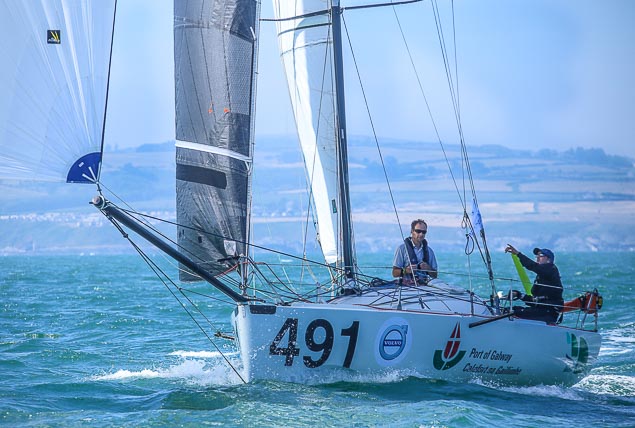 Yannick Lemonnier is getting a sensational performance out of Port of Galway, his 21ft Mini. Photo: Afloat.ie
Yannick Lemonnier is getting a sensational performance out of Port of Galway, his 21ft Mini. Photo: Afloat.ie
For now, Port of Galway is the star, the mighty atom and then some. As for the other Mini, there was a charming meeting at Wicklow in the pre-race festivities when Mini-Transat superstar Ian Lipinsky, doing this race in exalted style on Corum, called by to encourage Louis Mulloy of Westport and his crewman Arthur on their tiny craft 303 Blackshell Farm. Blackshell may not be achieving quite the same performance as Port of Galway, but she’s going some nevertheless, and is currently off Glandore and making 8.3 knots with a lot of very much larger boats tucked in well astern.
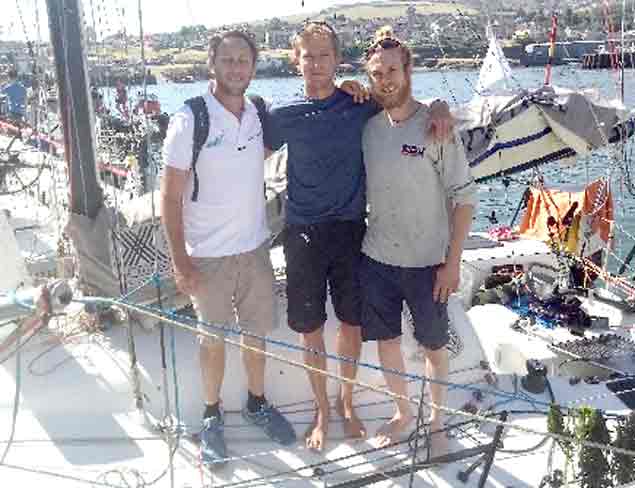 Meeting of Mini Transat fans – Ian Lipinsky in Wicklow with Louis Mulloy and Arthur from 303 Blackshell Farm
Meeting of Mini Transat fans – Ian Lipinsky in Wicklow with Louis Mulloy and Arthur from 303 Blackshell Farm
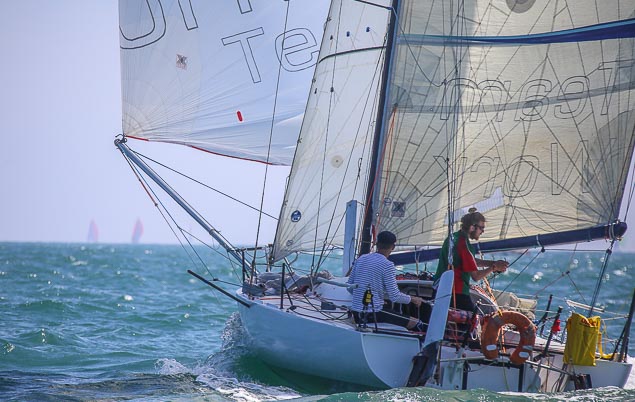 Tiny craft – 303 Blackshell Farm Photo: Afloat.ie
Tiny craft – 303 Blackshell Farm Photo: Afloat.ie
Race tracker here
Round Ireland Race Day 2: Drag Race Along South Coast
Day 2 of the Volvo Round Ireland Race 2018 finds the fleet enjoying freshening offshore breezes along the south coast to provide drag racing conditions and good speeds writes W M Nixon. But enjoyment is muted by the knowledge that beyond Mizen Head the wind is indicated as still from the north but stronger – 25 knots plus is currently shown for at least this morning along the Kerry coast.
Off the big country and out in the Atlantic, 25 knots plus right on the nose with the notoriously lumpy sea is much more than most boats’ optimal windward conditions. But for now, the going is good, and the overall leader on the water is the only multi-hull, Hugo Karlsson-Smythe’s trimaran Trilogic from the Netherlands. She’s nearing Toe Head in West Cork with 16.2 knots on the clock.
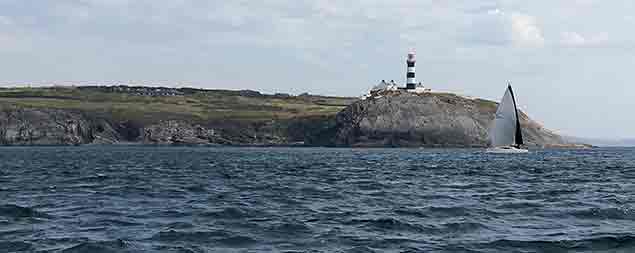 Paul O'Higgin's Rockabill VI passing the Old Head at 0945 this morning Photo: Chris Power Smith
Paul O'Higgin's Rockabill VI passing the Old Head at 0945 this morning Photo: Chris Power Smith
But almost level-pegging with her is one of the emerging stars of the show, the new Class 40 Corum from France being sailed in style by the three musketeers - Nicolas Trousel, Ian Lipinski and Aymeric Belloir. The classy Corum is currently registering 16.4 knots further out to sea, and already shaping up to put the Fastnet Rock astern.
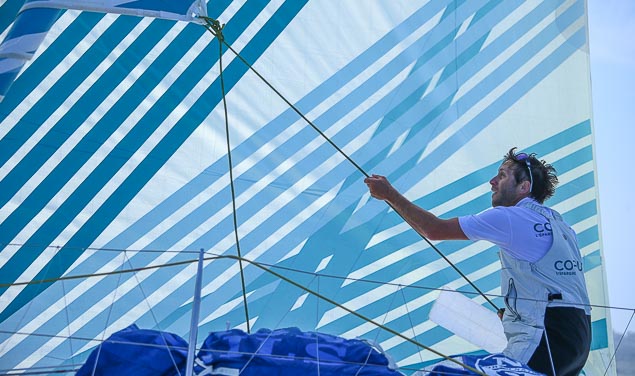 French sailing star and Mini Transat winner Ian Lipinski prepares for a sail change on Corum shortly after the start of the Round Ireland Photo: Afloat.ie
French sailing star and Mini Transat winner Ian Lipinski prepares for a sail change on Corum shortly after the start of the Round Ireland Photo: Afloat.ie
 Niall Dowling from the Royal Irish Yacht Club is skipper of the Ker 43 Baraka GP Photo: Afloat.ie
Niall Dowling from the Royal Irish Yacht Club is skipper of the Ker 43 Baraka GP Photo: Afloat.ie
Niall Dowling’s Ker 43 Baraka GP (Royal Irish YC) has put in a tremendous performance all the way down the south coast from the Tuskar Rock, and is currently fourth on the water, close astern of Sensation (France) the Class 40 Extreme. Due south of Galley Head with 11.4 knots currently on the clock, Baraka leads IRC on the water, and is third overall on corrected while leading IRC Class Z.
 Barry Byrne's Joker II is a defence forces sailing team Photo: Afloat.ie
Barry Byrne's Joker II is a defence forces sailing team Photo: Afloat.ie
However, it’s that pesky J/109s which had continued to trade the IRC overall handicap lead among themselves through the night, the most recent being Joker II skippered by Barry Byrne. But for now, the Joker is back in second overall as the IRC CT lead is held by the French Sunfast 3200 SNSP Hakuna Matata (Jean)Francois Nouel) with Joker II second, Baraka GP third, the JPK 10.10 Jaasap fourth, Paul Kavanagh’s Swan 44 CoOperation Ireland (aka Pomeroy Swan) fifth (good going for a two-hander), Stephen Quinn’s J/97 Lambay Rules from Howth sixth, Michael Boyd’s J/109 Jedi seventh, and Paul O’Higgins’ JPK 1080 Rockabill VI eighth.
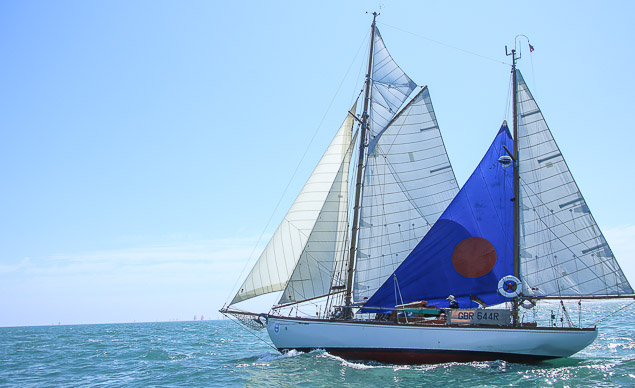 81-year old gaff ketch Maybird (Darryl Hughes), is south of Waterford Photo: Afloat.ie
81-year old gaff ketch Maybird (Darryl Hughes), is south of Waterford Photo: Afloat.ie
It has been a fast race so far, and even the most senior boat in the fleet, the 81-year old 43ft gaff ketch Maybird (Darryl Hughes), is south of Waterford and on course to put the Fastnet astern before nightfall.
By that time, way out beyond that iconic rock out in the open Atlantic, or seeking what smoother water they can find in towards the majestically rugged Kerry coast, the hotshots in the fleet will have been finding yet again that serious windward racing off Ireland’s western seaboard is tough going, for the vigorous north to northeast breezes currently are not forecast to ease significantly until this evening.
However, the current fast straight line progress sees the close placings changing frequently, and even as we post this Baraka GP has moved into the IRC overall lead.
Race Tracker here
Mach 40 Corum Took the Round Ireland Start With Style
It’s said that the boat which has made the best start is not always the one which seems first over the line, but rather it’s the boat which is in the lead five minutes after the kick-off writes W M Nixon. On those terms, the new Mach 40 Corum gave a master-class at this afternoon’s Volvo Round Ireland start in Wicklow by staying well clear of the kerfuffle out at the Guardship, and coming out of the line at the optimum angle.
Maybe she was lucky, with Niall Dowling’s Baraka GP shredding her kite to spoil the Ker 43’s otherwise perfect start. But then Corum also had to deal with Mark Emerson’s Phosphorous II (she looks to be the former Teasing Machine II, and therefore no stranger to the Ireland circuit) going like a train. But the guys on Corum had been susssing the area down towards Wicklow Head beforehand, and they read it to perfection, reckoning big-kite-setting was too much of a gamble, and getting their nose in front and holding the lead on the water while the crowds were watching.
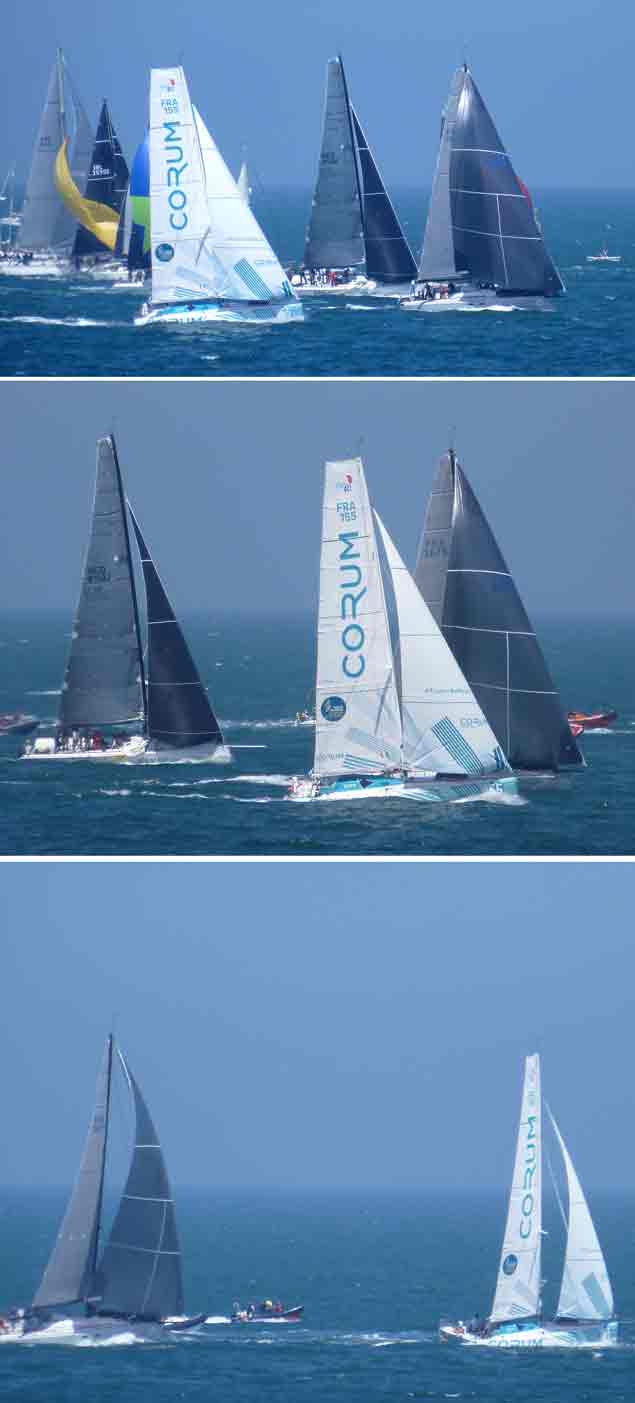 From top: Having calculated that the shy kite reach to Wicklow Head was too much of a gamble, Corum starts well inshore and just manages to keep her wind clear as she narrowly outsails Baraka and Phosphorous……(centre)…….it’s nip and tuck, but they’ve done it by the skin of their teeth…. (above) Job done. Photos: W M Nixon
From top: Having calculated that the shy kite reach to Wicklow Head was too much of a gamble, Corum starts well inshore and just manages to keep her wind clear as she narrowly outsails Baraka and Phosphorous……(centre)…….it’s nip and tuck, but they’ve done it by the skin of their teeth…. (above) Job done. Photos: W M Nixon
So having kept her total appearance a semi-secret until now, we could all see Corum is one gorgeous boat. But gorgeous boats and ordinary ones alike, they’re faced with the inevitability of adverse tides, even as the leaders are closing towards the Tuskar. This evening, the breeze is holding up quite well, and Michael Boyd with the J/109 Jedi is currently leading IRC overall, while on the water the former Volvo 60 Libertalia from France is narrowly ahead of the pack. But for the spectators, the new Corum won the start.
See Race tracker here.
Round Ireland Yacht Race 2018 is Taking Final Shape
For most of the Irish sailors who have committed to this year’s 20th staging of the biennial 704-mile Volvo Round Ireland Race on 30th June, it will be the central focus, the core pillar of their 2018 programme. And even though our increasing number of home-grown front-line international professionals might expect to see it as just another fixture in a busy worldwide working sailing year, they find that for anyone Irish, racing round Ireland continues to be something very special writes W M Nixon.
This was the abiding impression which emerged from this week’s decidedly convivial and crowded Round Ireland reception in the Royal Irish Yacht Club in Dun Laoghaire. This distinguished and ancient club of significant history has put its considerable muscle behind the much-smaller and more localised Wicklow Sailing Club (which inaugurated the Round Ireland in 1980) for the 2016 and now the 2018 staging of the race. The result has been a mutually beneficial relationship which sees the RIYC in its sheltered location within Dun Laoghaire Marina providing facilities for the larger Round Ireland contenders in the week leading up to the start.
 The sheltered and convenient location of the Royal Irish Yacht Club within Dun Laoghaire Marina
The sheltered and convenient location of the Royal Irish Yacht Club within Dun Laoghaire Marina
But as the actual start approaches, with this year’s scheduled for June 30th, the final days in the count-down see a total shift of focus down the coast to Wicklow, to a Wicklow which is completely en fete and totally in focus for this one event in a way which a large and complex harbour like Dun Laoghaire could never be.
In terms of planning a Round Ireland campaign, with five weeks to go you’re already well into the final stages, but nevertheless, there’s still the chance that some significant “we’ll show ’em” last minute entries might emerge to add to the 54 boats already listed. And as to that total figure, former organiser Theo Phelan – he stood down in the winter after guiding the event successfully to record numbers through the dark days of the economic recession – reckons it will probably be around 50 boats which finally cross the starting line.
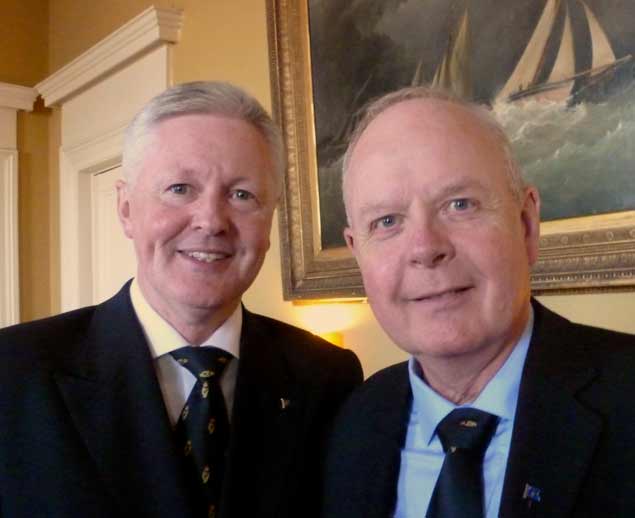 The Royal Irish YC’s newly-elected Commodore Joe Costello (left) and Vice Commodore Pat Shannon welcomed the Round Ireland party to their historic clubhouse. Photo: W M Nixon
The Royal Irish YC’s newly-elected Commodore Joe Costello (left) and Vice Commodore Pat Shannon welcomed the Round Ireland party to their historic clubhouse. Photo: W M Nixon
That’s a very respectable total, as the record fleet of the 2016 staging included the once-off appearance of George David’s Rambler 88, which won just about everything for which she was eligible, while there were also the three MOD 70 trimarans which also established what seemed like unbeatable records until later in the season, when the irrepressible Lloyd Thornburg with his MOD 70 Phaedo had another go, and chipped a little bit more off the time to leave what looks like a record so good it deserves to last.
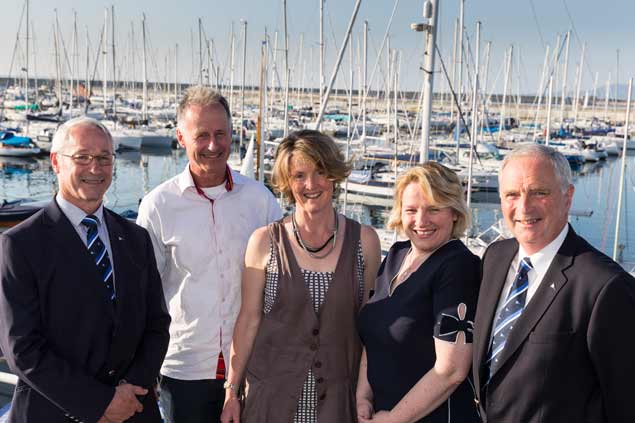 Wicklow SC’s Round Ireland Committee are (left to right) Hal Fitzgerald (Race Director), Kyran O’Grady (Hon.Treas.), Roisin Hennessy (Chairperson), Denis Cummins (WSC Commodore) and Peter Shearer (Hon. Sec.) Photo VRIYR
Wicklow SC’s Round Ireland Committee are (left to right) Hal Fitzgerald (Race Director), Kyran O’Grady (Hon.Treas.), Roisin Hennessy (Chairperson), Denis Cummins (WSC Commodore) and Peter Shearer (Hon. Sec.) Photo VRIYR
In a way, that Round Ireland Race of 2016 was standalone-exceptional, starting with the fact that George David felt honour-bound to do the race out of respect and for thanks after the crew of Rambler 100 were rescued off Baltimore when their keel broke off at the rock during the Fastnet Race of 2011. As for the era of the MOD 70s, that has peaked and gone.
So for 2018 we’re back to a more normal way of things, with a strong international entry which actually well outnumbers the Irish involvement - it is, after all, part of the international RORC Programme, counting for extra points. But nevertheless the inescapable theme of this week’s party was that this was a gathering of Round Ireland aficionados, or as Roisin Hennessy, the Chair of the Organising Committee put it, we had an assembly of Round Ireland virgins, serial offenders, and addicts, and if you were one of their number, the sense of mutual enthusiasm and fellowship filled the place with warm camaraderie.
 Peter Wilson (winner in 1994 and 1998), Paul O’Higgins (winner Dun Laoghaire to Dingle Race 2017, Round Ireland entrant 2018) and Roisin Hennessy (Chairperson, Organising Committee.) Photo: W M Nixon
Peter Wilson (winner in 1994 and 1998), Paul O’Higgins (winner Dun Laoghaire to Dingle Race 2017, Round Ireland entrant 2018) and Roisin Hennessy (Chairperson, Organising Committee.) Photo: W M Nixon
It was a good time to thank the many volunteers – it must be just about every member of Wicklow Sailing Club – who keep this show on the road, and after being welcomed by newly-elected RIYC Commodore Joe Costello, WSC Commodore Denise Cummins and David Thomas of Volvo Car Ireland were rightly effusive in their thanks to these dedicated helpers. And it was also rightly a time to give special thanks to the Race Directors past and present, for we’d three of them there – Dennis Noonan who was Mr Round Ireland for so long, then his successor Theo Phelan, and now former WSC Commodore Hal Fitzgerald.
Hal was candid in admitting that while he had some idea of the sheer quantity of work that his predecessors had undertaken to keep this unique show on the road, it wasn’t until it fell on his shoulders last winter that he got a true appreciation of what was involved - it is not a task to be undertaken lightly.
But it is now something which is built into the Wicklow DNA, so instead of dwelling on the backroom work involved, they generated an atmosphere of mirth and fond memories. Appropriately, there were presentations to Theo Phelan and his wife Orlagh, and Theo used the occasion for fond recollections of something rather special to the finish of the Round Ireland Race – the fact that each finishing boat is saluted by cannon fire regardless of the hour of day or night, or their placing in the race.
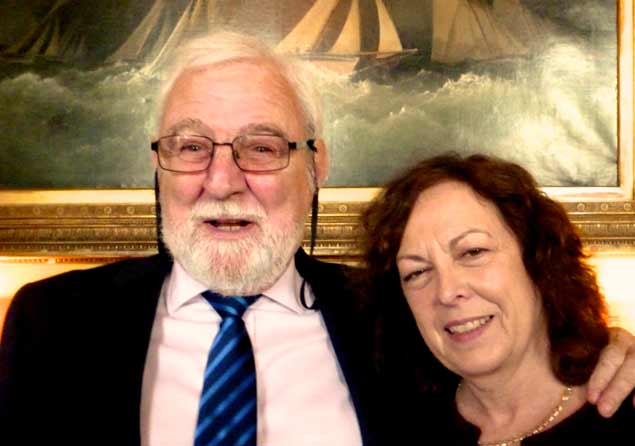 Theo Phelan and his wife Orlagh – Theo was Race Director for 2012, 2014 and 2016, and was closely involved for several races before 2012. Photo: W M Nixon
Theo Phelan and his wife Orlagh – Theo was Race Director for 2012, 2014 and 2016, and was closely involved for several races before 2012. Photo: W M Nixon
The empty cartridge from each cannon firing is then presented to the relevant finishing owner when he comes into the Race Office to sign his declaration, and Theo particularly recalls that great sportsman, France’s Baron Eric de Turckheim, when he came into the office, signed his declaration, and was presented with his cartridge shell. The rugged skipper of the highly successful Teasing Machine – highest placed boat overall after Rambler 88 herself and winner of many trophies – found his eyes welling up with tears. The cartridge meant more to him than all the silver and glassware which would follow in due course.
There were many such stories, for Round Ireland memories abounded, but to give it some focus they’d a panel discussion, moderated by David McHugh, for speakers Michael Boyd – highest-placed Irish entry in 2016 and overall winner in 1996 - Peter Wilson who won in 1994 and has been there or thereabouts in many races since, and journalist Elizabeth Birdthistle who was a complete round Ireland novice when she did the 2016 Race with Ronan O'Siochru of Irish Offshore Sailing in the 36ft Desert Star, and now spoke with eyes gleaming in all the zeal of the total convert.
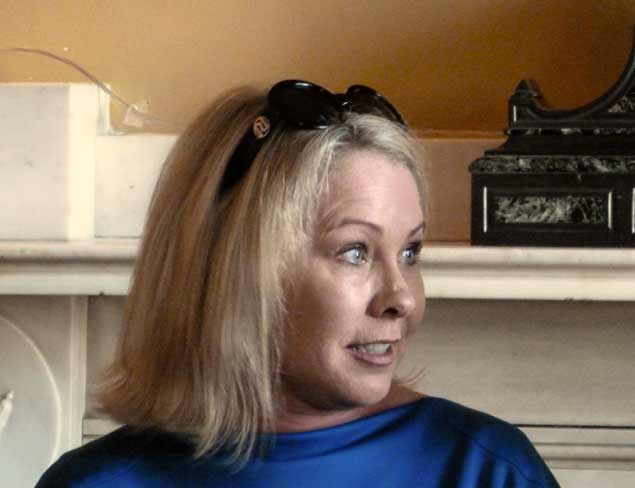 The gleaming eyes of the new enthusiast – Elizabeth Birdthistle talks of her first Round Ireland experience during the panel discussion. Photo: W M Nixon
The gleaming eyes of the new enthusiast – Elizabeth Birdthistle talks of her first Round Ireland experience during the panel discussion. Photo: W M Nixon
Peter Wilson is one of those fantastic skipper-helmsmen who somehow smooth a rough sea when you’re slugging to windward, yet can find an extra-helpful wave which no-one else had noticed when looking for that extra quarter knot off the wind. Talking to him before the panel discussion began, I naturally asked what angle he’d be taking, and being a man of few words he said he hadn’t a clue, yet once up there and speaking, his face lit up and he conveyed that special feeling which comes when a boat is in the groove and the going is very good.
Elizabeth Birdthistle brought a fresh perspective which reminded Round Ireland veterans of just what an extraordinary project a first tilt at the circuit can seem to be, and how it profoundly affects your life in the countdown, and continues to do so afterwards.
This was a theme taken up by former RORC Commodore Michael Boyd, who has helped to ensure the Round Ireland Race’s current exalted status. Put at its most simple, he persuasively argued that it was something that any true Irish sailor would like to be able to list in their CV at last once. But then he went beyond that, giving it all an almost spiritual dimension which made you think that in another life he would have made a rather good Abbot of Glenstal.
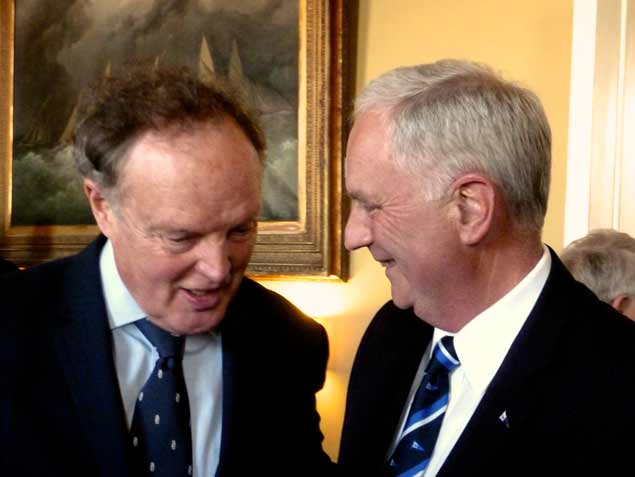 A word with the Abbot…….Michael Boyd - winner in 1996 and top Irish entry in 2018 – with Peter Shearer, Hon. Sec. WSC Photo: W M Nixon
A word with the Abbot…….Michael Boyd - winner in 1996 and top Irish entry in 2018 – with Peter Shearer, Hon. Sec. WSC Photo: W M Nixon
For he talked of the special bonds of camaraderie which become enduring friendships after sharing the Round Ireland experience, he talked of the sense of embracing Ireland in a very special way through doing it, and he talked of how the post-race buzz can in some ways last forever in a way that many of us who have done it have thought afterwards, but he managed to put it in an almost poetic style.
Such elevated thoughts were soon being balanced by competitive banter in the lively crowd, with positions being taken as to pre-race favourites, and there’s no doubt that local-boy-made-good Niall Dowling, returning with the hyper-hot Ker 43 Baraka GP, is highly-rated, as he has ace navigator Ian Moore calling the shots, while James Carroll is managing the boat, and Dalkey-based Kiwi star Jared Henderson is also on the strength.
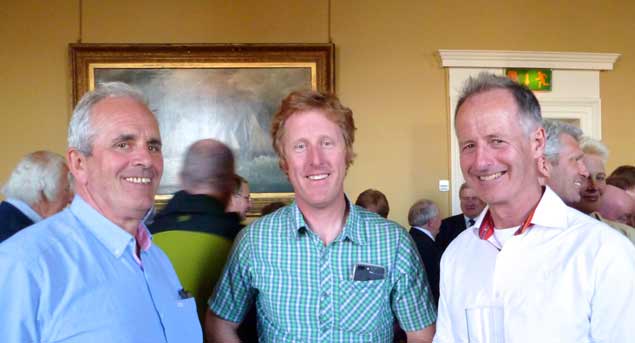 Brendan Coughlan (left) who will be racing his new Sunfast 3600 YoYo (below) in the 2018 Round Ireland, with Jim Carroll of Baraka GP, and WSC Hon Treas. Kyran O’Grady. Photo: W M Nixon
Brendan Coughlan (left) who will be racing his new Sunfast 3600 YoYo (below) in the 2018 Round Ireland, with Jim Carroll of Baraka GP, and WSC Hon Treas. Kyran O’Grady. Photo: W M Nixon

 The Ker 43 Baraka GP (Niall Dowling) is a much-fancied entry. Photo RORC
The Ker 43 Baraka GP (Niall Dowling) is a much-fancied entry. Photo RORC
But then Dowling’s former shipmate Michael Boyd has teamed up with the Irish National Sailing School’s Kenneth Rumball for a private entry of the school’s highly-tuned J/109 Jedi, and even though the design may now be 14 years old, you’re in a dream world if you under-estimate the race-winning potential of a well-prepared J/109, with Pwllheli’s Vicky Cox and Peter Dunlop with Mojito – Irish Sea champions in 2017 – also out there to give it their very best.
 The very image of a well-trimmed J/109. Mojito (Vicky Cox & Peter Dunlop, Pwllheli SC) in their home waters off Snowdonia
The very image of a well-trimmed J/109. Mojito (Vicky Cox & Peter Dunlop, Pwllheli SC) in their home waters off Snowdonia
As for their nemesis in last year’s Dun Laoghaire to Dingle race - Rockabill - her owner has signed up the formidable talents of Mark “Mono” Mansfield of Cork, and there’s just something about a JPK 10.80 which can pull off a real success when it’s really needed.
As usual in a fleet of this size, and a Round Ireland fleet at that, there’ll be an element of eccentricities in the entry list, and only Stephen O’Flaherty of Howth and RIYC would dream of racing his modern classic Sprit 54 Soufriere in such an event, particularly if they’d heard Peter Wilson talk eloquently of the experience of running down Ireland’s Atlantic seaboard in 40 knots of wind and more, while people back home on the east coast would be thinking it was just a normal mildly breezy summer’s day.
 Stephen O’Flaherty’s Spirit 54 Soufriere – a very individual choice for a Round Ireland racer
Stephen O’Flaherty’s Spirit 54 Soufriere – a very individual choice for a Round Ireland racer
For if there’s one thing a Round Ireland Race teaches you, it’s the exceptionally localised nature of our coastline’s wind strengths, and the way it can test a boat and her crew. I can still remember coming in past Inishtrahull with the most of a Force 9 up our backsides, and yet we knew that the big boats barely a hundred miles ahead down at the Maidens Rocks off Larne were becalmed. Either way, the experience seems at some distance from a cheerful party on a sunlit Spring evening in the time-hallowed surroundings of the Royal Irish Yacht Club.
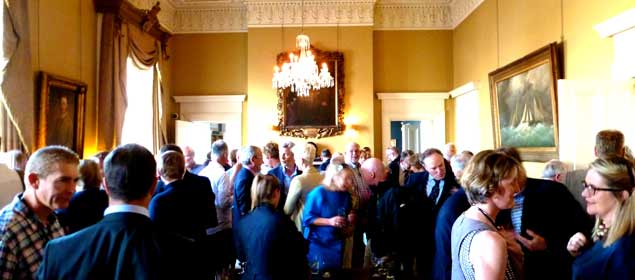 Party time in the time-hallowed surroundings of the Royal Irish YC – very different indeed from the conditions that may be experienced in racing round Ireland. Photo: W M Nixon
Party time in the time-hallowed surroundings of the Royal Irish YC – very different indeed from the conditions that may be experienced in racing round Ireland. Photo: W M Nixon
If it becomes a race of frequent calms, then the little fellows will simply have to sit it out and their handicaps will do the rest, but it’s the sheer unpredictability of the Round Ireland which is part of its unique attraction.
Another attraction for those ashore is that the entire starting sequence can be viewed from Wicklow pier. However, when it’s a reaching start, particularly with the wind offshore, the fleet tends to bunch towards the outer end, out at the Guardship, and well away from the pier.
After one such recent start, I happened to meet up with David Lovegrove, then President of the Irish Sailing Association and a noted International Race Officer, and he commented on the fact that the fleet ended up bunching in on the Guardship.
“If I were the Race Officer,” said he, “and we’d offshore wind conditions like this, I’d be very tempted to put a tiny bias in favour of the inner end of the line in order to keep the fleet in towards the pier and give the viewing public their moneysworth….”
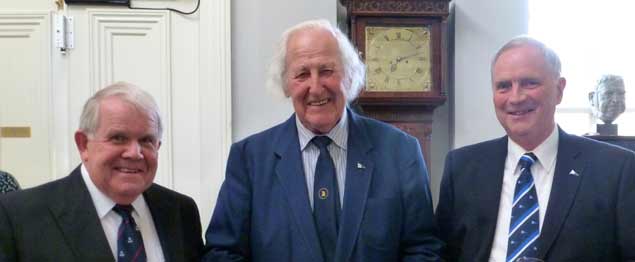 David Lovegrove, Race Officer for the Volvo Round Ireland Race 2018, with Dennis Noonan, Race Director for many years until 2010, and Peter Shearer, Hon. Sec. WSC. Photo: W M Nixon
David Lovegrove, Race Officer for the Volvo Round Ireland Race 2018, with Dennis Noonan, Race Director for many years until 2010, and Peter Shearer, Hon. Sec. WSC. Photo: W M Nixon
Well, as it happens, there was David Lovegrove at this week’s reception in the RIYC. And for why? Well, as it also happens, for the first time, he is going to be the Race Officer for the Volvo Round Ireland Race on June 30th. Interesting. Very interesting. We’ll certainly all be looking with extra fascination at the way that starting line is laid.
A wide field of international entries from the United States, Finland, Norway, France as well as Irish and British crews are amongst the 54 entries to date for the Volvo Round Ireland Race 2018 that was launched this evening.
Additional enquiries are still being handled by the Wicklow Sailing Club organisers though the 2016 record entry of 64 boats is unlikely to be matched this year.
The race was previewed a fortnight ago by Afloat.ie here
 Royal Irish JPK10.80 Rockabill VI (Paul O'Higgins) was the winner of last year's Dun Laoghaire to Dingle offshore race and is a pre–race Round Ireland favourite Photo: Afloat.ie
Royal Irish JPK10.80 Rockabill VI (Paul O'Higgins) was the winner of last year's Dun Laoghaire to Dingle offshore race and is a pre–race Round Ireland favourite Photo: Afloat.ie
In spite of the rugged 704 nautical-mile course facing the crews on the 30th June at Wicklow, a touch of glamour will be featured as Stephen O’Flaherty’s Soufriere, the elegant yacht from the James Bond movie Casino Royale is also entered. And Richard Loftus’s classic Swan 65 Desperado of Cowes will be the largest boat racing this year
 Stephen O’Flaherty’s classic Soufriere from Howth Yacht Club is going Round Ireland Photo: Afloat.ie
Stephen O’Flaherty’s classic Soufriere from Howth Yacht Club is going Round Ireland Photo: Afloat.ie
Several entries feature crews from Sailing Schools around the coast, many of whom are new recruits to the sport or fulfilling ‘bucket-list’ ambitions. The launch gathering heard from Elizabeth Birdthistle who sailed around Ireland in 2016 as one of a crew of ten such newcomers and she likened the race to the Camino de Santiago or a Mount Everest ascent.
“It was a very personal journey and I learnt about life doing it – it’s almost like a rite of passage for people who love the sea,” she told the audience gathered at the Royal Irish Yacht Club in Dun Laoghaire. “The Round Ireland Race IS the Wild Atlantic Way.”
Also, in the audience were a number of previous winners including former Royal Ocean Racing Club (RORC) Commodore Michael Boyd from Co. Meath, who won the race in 1996 and will be racing again this year.
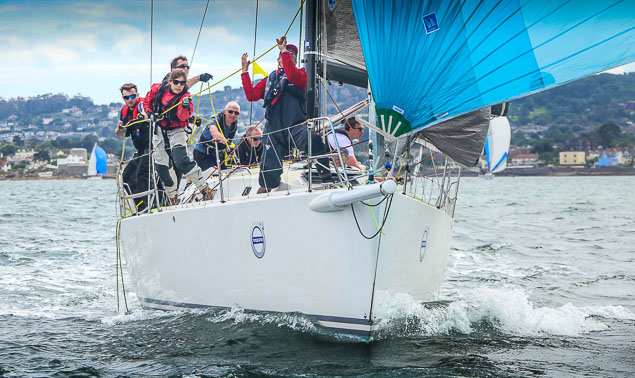 Chris Power Smith's ISORA leader Aurelia, a J122, is a Round Ireland Race entry Photo: Afloat.ie
Chris Power Smith's ISORA leader Aurelia, a J122, is a Round Ireland Race entry Photo: Afloat.ie
“This is a very attractive race for RORC sailors, not just because it’s an attractive course but also it earns bonus points in our annual series and we are delighted to see so many overseas entries for 2018,” Boyd said. “Every race is different and you never know until you’re back in the clubhouse just how you’ve done - there are very few double-winners.”
One such winner is Peter Wilson who won the 1994 race on Bridgestone and returned to win on Colm Barrington’s 1998 entry Jeep Cherokee. He shared memories of the highs and lows of the unique course with the audience.
“The highs would be going up the West coast of Ireland in 40 knots of wind for 200 miles in 1994, a sleigh-ride that will stick in mind for the rest of my life,” he said. Wind or rather, the lack of it was a low point in 1996 on Bootlegger and losing the race after getting becalmed for five hours off Greystones and obliged to anchor to stem the flood tide within sight of the finish.
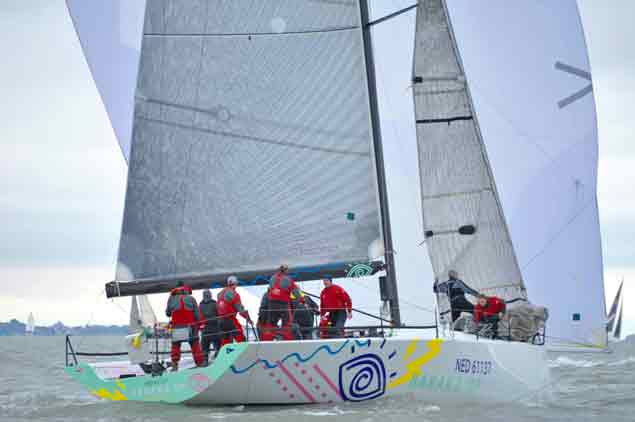 Niall Dowling's Baraka GP Ker 43 is a pre-race favourite
Niall Dowling's Baraka GP Ker 43 is a pre-race favourite
Another past race winner will also be making a return to the Volvo Round Ireland Race next month. Ian Moore from Carrickfergus was the navigator on Eamon Crosbie’s Calyx Voice & Data, the Ker 32-footer than won the race in 2004. He will be amongst a pro line-up for Niall Dowling on Baraka GP, one of the candidates for this year’s overall race win.
Click to see the full list of 2018 entries here
With just over 13 weeks to go to the start of the 2018 edition of the Volvo Round Ireland Yacht race, 37 boats have already taken advantage of the Early Bird entry rates writes W M Nixon. But the Early Bird offer closes this coming Friday, 30th March - if you’re interested in taking part in the history-making 20th Round Ireland, get your booking under way now here.
As it is, a quick scan of the current confirmed entries reveals a decidedly eclectic list of notable boats. Dun Laoghaire-Dingle 2017 runner-up, the ISORA all-conquering J/109 Mojito (Vicky Cox & Peter Dunlop, Pwllheli) is game for the complete circuit, while Chris Power Smith’s J/122 Aurelia, another ISORA stalwart, is also going again.
The keenly-campaigned veteran Swan 65 Desperado of Cowes (Richard Loftus) is adding the Round Ireland to her list of battle honours for the second time, and the first signs of the Open 40s making a race of it (they find the Round Ireland suits them particularly well) is there with Ari Kaensaekoski’s Fuji.
Another veteran Swan, this time Paul Kavanagh’s Swan 44 Pomeroy Swan, is doing the race for the first time, but she’s well known on the RORC circuit as sailing for Ireland, and was a notable performer at the front of the fleet in the Rolex Fastnet Race 2017.
Dun Laoghaire-Dingle Race 2017 winner Rockabill VI, Paul O’Higgins’ JPK 10.80, is going again, but this time with 2016 Class Winner Mark Mansfield of Cork in the crew, while the veteran French Volvo 65 Libertalia is game for another go. And as for boats which are currently top of the rankings in Irish sailing, the sister-ship of “Sailor of the Year” Conor Fogerty’s Sunfast 3600 Bam!, Brendan Coughlan’s recently-acquired YoYo, has also signed up.
Round Ireland 2018 Entries at March 27
303 Black Louis Mulloy
Andante Keith Miller
Arthur Logic John Tyrell Prue Walsh
Aurelia Chris Power Smith
Baraka Niall Dowling
Bellino Rob Craige
Desert Star Irish Offshore Sailing Ronan O Siochru
Desperado of Cowes Richard Loftus
Fireball Chris Clark
Forward Thinking Tony Martin
Fuji Ari Kaensaekoski
Fulmar Fever Robert Marchant
Hydra Henrik Bergesen
Jaasap Pasternak Nicholas
Jangada Richard Palmer
Laura Richard Stain
Libertalia Team Jolika, Jean Francois Levasseur
Lynx Clipper David O Connor
May Contain Nuts Kevin Rolfe
Maybird Darryl Hughes
Mojito Peter Dunlop & Vicky Cox
Olympia's Tigress Susan Glenny
Patriot John Lubimir
Pegasus Of Northumberland Ross Hobson
Petasus Al Smith
Phosphorous II Mark Emerson
Platinum Blonde Paul Egan
Playing Around Ken Docherty
Pomeroy Swan Paul Kavanagh
Port of Galway Yannick Lermonner
Pyxis Kirsteen Donaldson
Rockabill VI Paul O'Higgins
Sherkin 2 Ronan O'Siochru
Tribal Liam Burke
Trilogic Hugo Karlsson-Smyth
Wild Spirit Paul Jackson
Yoyo Brendan Couglan
New Race Director for 2018 Volvo Round Ireland Yacht Race
Wicklow Sailing Club's Volvo Round Ireland Committee has announced the appointment of Hal Fitzgerald as Race Director following the decision of Theo Phelan to stand down from the role, as Afloat.ie reported yesterday.
Fitzgerald is an ex-commodore of Wicklow Sailing Club and has been closely involved with running the race in previous years.
With 16 weeks until the 20th edition on 30th June 2018, entries continue to grow. 27 boats are currently entered for the race. Interest in the race once again extends far beyond Ireland and Great Britain, with entries from across Europe, including Team Jolokia from France aboard Libertalia. See the entry list here.
The largest boat confirmed to date is the Swan 65 Desperado of Cowes entered by Richard Loftus.
Dun Laoghaire's Ronan O’Siochru, will be competing in his fifth Volvo Round Ireland in a row.
Early bird entries closing date is 30th March.



























